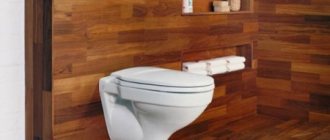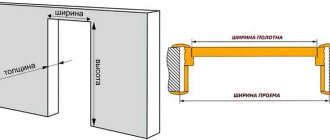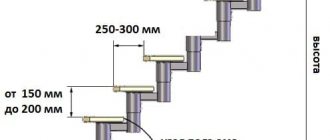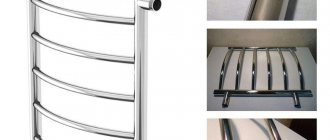Standards in construction and renovation
Author: jk.335500Jul 25, 2019Jul 25, 2019
When arranging a bathroom in a residential or office space, convenient placement of plumbing fixtures and furniture is necessary. The height of the bathroom sink is specified by SNiP regulations, which are advisory in nature. Drawing up a layout of components in the bathroom is complicated by the small size and increased functional load on the room.
Bathroom.
- 1 Optimal sink height according to SNIP
- 2 Installation of the sink in relation to other appliances
- 3 Is it possible to move the sink
- 4 Do I need to follow the standard?
- 5 Practical calculation of optimal height
- 6 Types of sinks and installation heights 6.1 Sinks with a choice of heights
- 6.2 Fixed height
- 6.3 Height adjustable
Optimal sink height according to SNIP
Current sanitary standards SNiP section 3.05.01-85 require the edge of the sink to be located at a height of 800-850 mm from the floor. The requirements apply to residential and public premises. Regulatory acts allow deviations from the specified values in the direction of increasing or decreasing by 20 mm. The parameters are designed for a person of average height, so the standard height of the washbasin is inconvenient for tall people.
Optimal washbasin height.
There are additional sections of SNiP that regulate the installation height of washstands in child care institutions:
- for nurseries - 400 mm from the floor surface;
- for preparatory preschool groups - 500 mm;
- for bathrooms in primary school premises - from 550 to 600 mm;
- for middle and high schools - from 650 to 850 mm.
Selection of design for installation at the desired height
Wall-hung sink installed at any height
If the standard height of the sink installed in the bathroom (approximately 85 cm) is not satisfactory, then choose one of the options:
- Installation of a wall-hung sink at any height. This method is the most affordable and convenient, especially recommended for a bathroom used by a disabled person - there is room for feet under the washbasin.
- Manufacturing of a cabinet for a mortise or countertop sink, a bowl-table top to order according to individual sizes. This is the most expensive method - a non-standard floor cabinet always costs more, sometimes the price difference is 100%.
- Buying a sink with a pedestal or console higher or lower than the standard 85 cm. The choice of such plumbing fixtures is now unlimited. The console of the required size, like the cabinet, can be made to order.
It is not necessary to comply with the standard requirements for installing a washbasin. If, when choosing an inexpensive sink, the ability to install it at any height is of decisive importance, then the best option is wall-mounted. It is better to hide the pipeline in a box - the appearance of the bathroom does not deteriorate; if a leak occurs, it is easy to gain access to the damaged pipes.
Installing the sink in relation to other appliances
Distance in the bathroom of furnishings.
The distance from the sink to the rest of the interior of the bathroom or combined toilet is regulated by the requirements of SNiP 3.05.01-85. The standards are developed based on the area of a small apartment, where it is important to use every centimeter of space. For example, the size of the free zone in front of the washbasin must be at least 700 mm (when installing the equipment on the wall). When placing the sink in a special niche, the radius of the free zone increases by 200 mm.
Minimum distance from the sink to the rest of the equipment (in accordance with SNiP):
- to a floor-standing toilet or bidet - 250 mm;
- to the edge of the bathtub or shower cabin - 300 mm;
- to the side walls of the room - 200 mm;
- to the heated towel rail pipeline - at least 600 mm;
- to household power outlets - 600 mm.
Installation of a washbasin, popular models
Freestanding floor-mounted sink
The installation height from the floor and the possibility of changing it depend on the type of plumbing product. Connecting the bowl to the water supply and sewerage is carried out according to the same scheme, regardless of its type. Sinks differ from each other only in the method of installation and appearance. It is better to entrust the installation to a professional plumber - the cost of the service starts from 1000 rubles.
Floor-standing
The names of floor-standing sinks are with a stand, with a pedestal, “tulip”, on a pedestal. The support is either included in the kit or is integral with the bowl. Advantages - the water pipes are hidden inside the pedestal, part of the load from the weight of the sink is taken by the stand. This is an option for installing a washbasin near an interior partition or a thin wall.
Types of floor-mounted bathroom sinks:
- Floor monolith. The devices do not have a separate support. The washbasin has the appearance of a solid cabinet made of one material.
- With console. Instead of a pedestal, they have four supports.
A common drawback of all floor-standing models is that it is impossible to adjust the installation height, so before purchasing you need to accurately measure the appropriate size. The height of sinks supported on the floor is from 80 to 101 cm. An option to solve the problem of choosing a convenient size of a monolithic washbasin for the bathroom is to make it yourself from concrete.
Wall-mounted (suspended)
Wall design
Wall-hung sinks are bowls without support. They are attached to the wall using special brackets or anchor screws with dowels (only mini-sinks or washstands). This type of washbasin is easiest to “adjust” in height to the height of those who will use it. The disadvantage of wall-hung sinks is that the pipes and siphon remain visible. Ways to solve this problem:
- Installation of ready-made or home-made plasterboard boxes, extruded polystyrene panels, chipboard. It can be tiled or painted.
- Concealed installation of the pipeline. This option involves gating the walls - the cost of a specialist’s work is from 400 rubles per linear meter.
Types of wall-mounted washbasins:
- Cantilever with two legs. They are attached to the wall with brackets or dowels. The legs take on part of the weight of the sink and act as additional support. Disadvantages - due to the presence of stands of a strictly defined size, it is impossible to adjust the height.
- With shortened console. The support of such a washbasin does not reach the floor. Mount the device to the wall only. The advantage is that the installation height is arbitrary.
- With a semi-pedestal-stand that reaches the floor and is made of the same material as the bowl. The advantage is that this is the only type of wall-mounted sinks in which the pipes are hidden. The disadvantage is that the dimensions of the half-pedestal are fixed, so installation of the washbasin is possible at a strictly defined height. This often creates problems if the utilities were installed before purchasing the sink.
- For installation above the washing machine (flat). Disadvantage: the installation height depends on the size of the equipment. In order for the sink to be at a standard level, the washing machine must have a height of no more than 70 cm. Such models exist, but are designed for a load of no more than 3.5 kg. This minus is conditional, since if family members are tall, then you can put a regular-sized machine under such a bowl.
- Countertop sink. This type of washbasin has one or two wide wings and can serve as a cover for a cabinet installed in the bathroom, or be mounted like a regular wall-mounted bowl. If you use a sink as a countertop for a base cabinet, then the installation height will be limited by its size.
For some models of wall-hung sinks, pedestals and half-pedestals are sold separately (at the buyer's choice).
Mortise (built-in)
Built-in washbasin
A hole is cut out in the countertop or top cover of the cabinet for the built-in bowl. The installation height of such a sink depends on the size of the floor cabinet in which it is mounted or is arbitrary if the bowl is embedded in a hanging countertop.
Flaws:
- the cutout must be carefully treated with sealant, otherwise the cabinet material may swell;
- if the bowl is built into a suspended tabletop, then the pipes are visible.
A type of mortise bowl is a semi-recessed sink. Its back part is inserted into the cabinet tabletop, the front part hangs over the floor. Disadvantage: the installation height depends on the size of the cabinet.
Invoices
A countertop sink is a bowl mounted on a hanging countertop or cabinet. The advantage is that it is easy to ensure reliable sealing, which extends the service life of the surface on which the washbasin is placed. When choosing the option with a hanging countertop, the installation height of the overhead bowl is arbitrary, but, like wall-mounted ones, the pipes are visible.
Laundry (technical)
A special type of sinks is laundry or technical (for hand washing). The bowls are deep, often have an inclined corrugated wall on one side, their surface is covered with dirt-repellent material, and the drainage is enlarged. Like regular sinks, laundry sinks can be floor-mounted, wall-mounted, recessed or countertop. The installation features are the same. When choosing the mounting height of a technical model, you can focus on the height of only one person - the one who will use it.
For people with disabilities
There is a special type of washbasin on sale - for disabled people using a wheelchair. They have a special shape - the front edge of the bowl is concave inward, the sides act as armrests. It is convenient for a person in a sitting position to approach such a sink.
It makes sense to use washbasins for people with disabilities if the disease is chronic. When installing, remember that the installation height of any sink in a bathroom for the disabled is much lower than usual (see SNiP above). The cost of these devices is on the same level as simple bowls of the average price category (from 4.5 thousand rubles). If the violations are temporary, then it is easier to install metal handrails near the washbasin, located at a standard height - the price starts from 1.2 thousand rubles per set.
Is it possible to move the sink
When renovating a bathroom, there may be situations that require changing the arrangement of elements:
- Rearranging equipment within the premises. For example, if the owner wants to turn the bathtub 90° and move the sink into the vacant corner, then he does not need to obtain additional documents for this.
- Moving the sink in the bathroom (heightwise or to the side). The distance and installation location are chosen by the owner of the premises at will. No documentation is needed for the transfer.
- Installing an additional washbasin in a bathroom also does not require special permission.
- Removing the sink into a residential area requires filing an application for such changes. Since the ceilings of rooms do not protect against water leakage, such reconstructions are prohibited by regulatory authorities. Detection of unauthorized alterations will result in a fine and a requirement to remove the sink and water pipes from the premises.
The special permit is not required to specify the installation of an additional washbasin.
Basins with a choice of heights
Wall-hung sinks and washbasins with a semi-pedestal allow you to independently determine the installation height.
The wall-hung basin allows you to choose the installation height.
A sink with a semi-pedestal allows it to be installed at a convenient height from the floor.
Note! The installation height of hanging bowls and sinks equipped with a semi-pedestal still depends on the location of the supply lines. Therefore, at the stage of supplying water pipes and sewer drains, the future height of the sink installation should be taken into account.
Wall-hung sinks are attached directly to the wall using brackets on which the bowl is hung. These types of washbasins are installed on solid walls that have the necessary load-bearing capacity. After installing the sink, it is connected to the water supply and sewerage system.
Washbasins with a semi-pedestal are installed in a similar way. The semi-pedestal is mounted after connecting to the communications and is attached using dowels and screws to the wall or suspended on special brackets directly to the bowl.
Read more: How to install a sink in the bathroom.
Do I need to follow the standard?
The standard sink installation height is observed when renovating bathrooms in government institutions, schools and preschool institutions. In a residential area, the owner himself plans the level of installation. If both adults and children live in the apartment, it is necessary to provide for the use of plumbing by the child. In country houses, sinks of the “moidodyr” type are often used, having a standard height of 850 mm. The water tank is installed separately, which allows you to install the tap at a convenient level.
At dachas, Moidodyr sinks are used.
Sink installation
Many users are interested in how to secure the bowl. Many people believe that the best mounting options are wall-mounted brackets, as they will securely hold the sink in place.
Sink
Tulip-type structures are rarely installed with support on one leg. The pedestal often acts as a decorative element that helps hide the pipes leading to the sewer hole.
When the owner has made the calculations, decided on the height and purchased the sink, you can begin installation.
In order for the plumbing fixture to hang firmly on the wall, it must be properly fixed. To do this, adhere to the following algorithm of actions:
- The required height for installing the bowl is marked on the wall.
- Measure the height from the holes that are intended for attaching the washbasin to the top of the sink. The resulting number is laid down from the first mark.
- An intercenter step is placed at the second mark and a hole is made.
- Apply the brackets, mount them, and then hang the bowl. Then they begin to fix the mixers and connect the siphon to the sewer.
Sink installation
Practical calculation of optimal height
To determine the installation level, a technique based on a comfortable hand position is used. Studies have shown that the distance between the working surface of the washbasin and the user’s elbows should be from 50 to 80 mm. The owner of the premises can independently calculate for himself the distance based on which water pipes and drainage will be installed.
The distance from the sink and the user's elbows should be 50-80 mm.
Algorithm for calculating the distance from the floor to the top edge of the sink:
- The user stands on the bathroom floor and an assistant measures the distance from the floor to the elbow.
- From the obtained value, the size of the gap between the sink and the elbow is subtracted (50-80 mm).
- This parameter is reduced by the height of the washbasin, which the owner of the room must select in advance.
- If the bathroom is not finished, then the type of flooring that will be used in the room is additionally taken into account. When calculating, you must remember that the floor will rise to the height of the tiles and the thickness of the adhesive layer. If leveling the coating or installing floor heating is planned, this is also taken into account when calculating the installation height of the sink.
- The height is increased by the thickness of the floor covering. The obtained value allows you to comfortably install a sink for one family member, so similar parameters are calculated for other residents using a similar method. The results obtained are averaged (for adults), and the sink is set at a level that is comfortable for all family members.
Why follow the standard?
As a rule, the usual installation of a wall-mounted or counter-mounted sink does not cause any complaints; the optimal height established by SNiP is suitable for most people. Not for nothing, because sets, which consist of a washbasin with a pedestal, or a “moidodyr” cabinet with a built-in sink, are produced with a height of 80-85 cm.
But if plumbing fixtures with a standard height do not suit you for some reason, then for convenience you can safely change the installation height of the sink, since it will be most convenient for you to operate it.
For a family with small children, installing a separate washbasin for children in a small bathroom is not possible. Especially for this situation, furniture manufacturers produce special sink cabinets with a pull-out step.
A good option would also be to buy a special footrest, which will allow children not to experience inconvenience while washing. It is worth noting that all the rules and regulations of SNiPs and GOSTs are valid only in multi-apartment residential buildings, where the buildings themselves strictly obey these rules.
For owners of private houses, cottages and mansions, installation or redevelopment does not require any permits or approvals, and compliance with standards depends only on the desires of the owners.
Choosing the height of the washbasin is a serious and responsible matter, so you need to approach this issue extremely responsibly. Experts have determined that the optimal distance from the floor to the edge of the sink is different for men and women; for men it is 85-102 cm, and for women 80-92 cm.
However, the established size in neither the first nor the second case is acceptable for a family with children. It is good if it is possible to install a separate sink for children, but often all family members have to use one appliance. Then you can choose something in between, hanging, for example, a washbasin at a height of 80-95 cm. And for children you can buy a special stand.
Types of sinks and installation heights
Bathroom sinks vary in shape, color, side height, type of material and method of fastening. The owner selects equipment based on the size of the room and the required level of installation. For example, small sinks with a width of up to 450 mm are used in bathrooms, and products with a width of 550 to 750 mm are installed in the bathroom.
Types of sinks in the bathroom.
Types of sinks:
- Suspended type devices located anywhere in the room. Flexible hoses are used to ensure water supply and drain contaminated liquid. The disadvantage of the design is the open location of the siphon. In addition, the space under the sink remains unused.
- Equipment equipped with a “pedestal” of a fixed size. The advantage of the design is the ability to place hoses inside the “pedestal”. Manufacturers produce bases with different dimensions, which allows you to adjust the installation level of the sink.
- Sinks with cabinets, inside of which there is a siphon and connecting hoses. When making furniture to order, it is possible to change the position of the sink. It should be taken into account that particle board is destroyed by moisture.
- Special equipment with a convenient height adjustment mechanism. It is characterized by high cost.
Sink with cabinet in the bathroom.
Basins with a choice of heights
The owner of the premises can independently determine the installation height of the washbasin. This is possible when installing a wall-mounted product or a sink equipped with a “half-pedestal”. The installation level of such equipment is determined by the height of the water pipes and sewerage outlets. The location of the lines is taken into account when carrying out renovations in the bathroom.
Hanging sinks in the bathroom.
Hanging equipment is installed on the walls of the room using decorative brackets or through holes made on the back wall of the product. The brackets provide additional fixation of the bowl using screws or guide pins.
Since the products weigh more than 10 kg, installation must be done only on solid concrete or brick walls.
After installing the fixtures and sink, flexible hoses for supply and drainage are installed; the section under the sink can be covered with a floor cabinet.
Wall-hung sink with cabinet in the bathroom.
Then the attachment points for the decorative casing are marked on the wall, which is attached to the wall with screws screwed into plastic dowels. The installation height of the washbasin is limited only by the size of the “semi-pedestal”, which is in the range of 400-500 mm.
Fixed height
The category of equipment with a fixed mounting height includes sinks with a “pedestal”. The base can be placed on the floor covering or placed on a brick or concrete platform. It is possible to reduce the dimensions of the “pedestal” by cutting off the area at the top or bottom, but when cutting, the earthenware cracks and splits. A neat cut can only be made on a machine (without guaranteeing the quality of the work performed).
Pedestal sinks in the bathroom.
Another option is equipment designed to be inserted into a tabletop, which is mounted on brackets or on a cabinet. The overhead washbasin is placed in a pre-made hole; a factory template (included in the sink kit) is used to determine the configuration.
Then the product is installed flush with the surface and fixed using standard plates. The installation diagram does not impose strict requirements on the height of the sewerage system or the location of the outlet of water pipes.
Sink in the bathroom above the washing machine.
In small spaces, the practice of installing a sink above a washing machine is practiced. The equipment has an original shape with a reduced depth of the washing part. The sink is hung on the wall using a special fastening; a siphon of a non-standard shape is used to ensure the drainage of dirty water. Some modifications are not equipped with a window for mounting the mixer, and the distribution tap will be located on the wall of the room.
Between the lower edge of the sink and the upper plane of the machine body, it is required to maintain a gap of 150-200 mm, which reduces the risk of damage to the equipment by vibration that occurs during operation. Taking into account the height of the sink side in the range of 80-100 mm and the height of the washing machine body from 700 mm, the installation height is in the range of 930-1000 mm, which exceeds the standard values. This installation scheme is suitable for people 180 cm tall and above.
With height adjustment
Equipment with a smooth height adjustment function is designed for people who use a wheelchair. The sinks are designed for use in medical institutions, but they can be used at home. To adjust the position of the sink, a mechanical or pneumatic drive is used. Installation of the washbasin begins with marking the surface of the wall on which the base of the rod is attached to move the carriage with the installed sink.
Sinks with height adjustment.
The design of the equipment includes elastic water connections and a special flexible hose connecting the drain channel to the sewer pipe (parts must be purchased separately). To adjust the height, use a lever located on the left or right side of the sink. The switch operates a mechanical actuator or pneumatic control valve that supplies air to the actuator cylinder.
The height adjustment range of the product is from 200 to 400 mm (depending on the manufacturer and design features).
The German manufacturer Viega supplies sinks with a console adjustment mechanism. The device is mounted discreetly in a niche under the sink; there is a decorative screen covering the hose connection points. To control the position of the washbasin, a button located on the wall is used.
The maximum height adjustment range is 200 mm. The set with the sink contains all the necessary components for installation and connection.
Similar articles
Standard dimensions of a bathroom in Khrushchev
How much does an acrylic bathtub weigh and what weight can it withstand?
Features of bathroom ergonomics
Types of sink designs
Sinks are sold in different shapes. This must be taken into account when calculating the installation from floor to bowl. Let's take a closer look at the features of each accessory:
- Sinks or washbasins placed on a pedestal are a tulip. This is a frequently encountered variety. It is sold complete and attached to the stand. Therefore, this design has set dimensions that cannot be changed. If it is 90 cm long, then you will have to adapt to it. When installing on the floor, you need to fix the base and attach the bowl to the wall using brackets so that it rests against the pedestal. The advantage of this type is that it helps to hide the siphon, which is located inside the structure. The external design looks quite neat. Such structures have an installation height of 85–90 cm, which is considered a standard indicator.
- Hanging washbasins in the bathroom, attached to the wall. They are ergonomic and functional and do not take up extra space in the room. They can be installed at any distance from the floor surface. If the owners are short (for example, 164 cm), then the sink can be fixed at a height of 75–80 cm. Visually, the siphon will spoil the design of the room, although for this model it will not be difficult to find it. If there are small children in the apartment, it is not recommended to place the product too low. Installation will be inconvenient for an adult, but children will soon grow up and use the sink will become easier. Therefore, it is better for the child to purchase children's steps or a high chair that will help him reach the tap.
- Built-in structures. They are mounted on a countertop. They look like the famous Moidodyr from the cartoon. They have a classic size, which is related to the parameters of the furniture. The table itself and the cup can be large and occupy the entire space of the tabletop. There are sinks that are smaller in size than countertops, then the free space is used for their own purposes. For example, they store cups with brushes and paste, and place a soap dish or dispenser with liquid soap. Such models are manufactured according to sanitary standards, and they have standard height dimensions. You can also order a sink to have it made to your specifications. Then the dimensions of the tabletop will be acceptable.
- Accessories for the bathroom, with possible adjustment of installation height. It seems that this design is the most convenient, since every member of the household can customize it for themselves. In practice, the cost of such an installation is quite high, it is difficult to install, and it breaks down quickly if it is not treated with care.
Tulip
Fixed height washbasins
Models that have a fixed installation height include the following types:
- Sinks with pedestal (tulip). There is one caveat here though. If desired, the pedestal can be placed on a concrete platform or parapet, thus increasing the installation height. You can also saw the pedestal and install a shortened version on a concrete pad, but the process of sawing earthenware can damage the product.
The pedestal washbasin has a fixed installation height. - Overhead and built-in (mortise) bowls. The installation height of these types of washbasins depends on the height of the support on which they are installed: countertop or cabinet.
The location of overhead and mortise sinks depends on the height of the cabinet or countertop on which they are installed. - Another type of washbasin that has a fixed installation height is lily pad sinks, designed to be installed above a washing machine. Depending on the dimensions of the washing machine, sinks are hung on brackets fixed at a height of 700–900 mm. An important nuance in installing this type of sink is that there should be a small space (30–50 mm) between the bowl and the body of the washing machine so that when the machine vibrates in spin mode there is no contact with the sink.
The water lily sink is installed at a fixed height above the washing machine.
Sink fixation schemes
Industrial production has made great strides forward and has developed many types of accessories. At the same time, not only the external design and shape of the devices differ, but also their installation schemes.
Installation of the sink at the design height
Classic installation involves installing a sink using two brackets. They are fixed to the wall, the plumbing fixtures are simply placed on them, and then the pipes are connected. But with this option, you need to correctly determine the distance from the floor to the top of the sink. When installing in the kitchen, you should consider some nuances:
- convenient pipe supply;
- calculating the optimal length between brackets;
- leveling with a building level in the horizontal plane;
- load, product weight.
Location by level
The accessories are heavy and large in size. In view of this, the sink installation plan is thought out taking into account the expected load. The brackets are fastened with screws that can support the weight of 2 times more than the sink.
This is interesting: Design of a bathroom in a house with a window: let’s find out in order
Conch transfer is a violation or not
Standard (standard) - translated from English means norm, sample. This is something that serves as a standard, a template, and does not contain anything unusual or original.
In our case, the standard height for installing a sink in a bathroom, as mentioned above, is 80–85 cm. This is how washbasins will be installed by a team of plumbers in a new building - according to building codes.
But when renovating your own bathroom with your own hands, you want, and sometimes have to, deviate from the rules, do something interesting, unusual, non-standard.
Is it possible? And what will be considered a violation of SNiP and what will not? Which works require approval from the authorities and which do not? Let's figure it out.
For whatever reason, you decide to swap your sink and bathtub. If all the work is carried out within the bathroom, then this will not be a violation of the rules; nothing needs to be agreed upon. It is enough to invite an authorized representative and hand over the completed work.
Changing the height of the sink
This type of work does not require permission; the height of the washbasin from the floor to the top edge may not meet the standards and is chosen at your own discretion.
Installing a second washbasin
Installing another appliance in the bathroom does not require approval, but if you decide to move the sink outside the bathroom, then this will already be a remodel. Without permission from the relevant authorities, the transfer is considered a violation of SNiP. At best, the authorized representative will prohibit the work, at worst, issue a fine.
Standard sink height
As for the installation standard for the height of the sink from the floor in the bathroom, like other plumbing equipment, it is directly related to the physiological data of people. In turn, height depends on the age and gender of a particular person. There is no single mandatory figure that determines the distance of the washbasin from the floor surface. But there is a recommended standard height for a bathroom sink.
It represents the distance between the floor surface and the upper horizon of this device, taking into account the return category for:
- older people with an average height of 800 millimeters;
- teenagers of average height – 700 millimeters;
- children with an average height of 600 millimeters.
As for owners of households, cottages and apartments, many of them rarely take into account the standard height of the washbasin in the bathroom from the floor. Typically, installation is carried out taking into account personal preferences and individual ideas about comfort and convenience when taking hygiene procedures.
But still, experts recommend maintaining a distance between the floor surface and the edge of the sink, which is in the range from 750 to 850 millimeters.
This is interesting: Budget renovation of a bathroom with your own hands - we explain thoroughly
conclusions
Calculating the position of plumbing fixtures and auxiliary equipment, furniture and accessories in the bathroom does not necessarily have to rely entirely on statistical data and SNiP. To check whether the standard height of a bathtub from the floor with legs or the height of the faucet above the bathtub is suitable for a particular family, it is worth “estimating for yourself” the ergonomic parameters of the room and choosing the optimal placement option.
To check standard sizes, help is needed - with a tape measure or a long ruler, an assistant determines the difference between standard and individual data and selects a specific value from the proposed ranges.
Types and dimensions of washbasins
Plumbing manufacturers today offer a wide selection of washbasin models, which differ in material, height, shape and even capacity.
"Tulip"
This is a washbasin that has the shape of a blossoming flower located on a thin stalk. In many cases, such products are made of ceramics, but models made of glass or metal are not uncommon.
The bowl is made in the shape of petals, complemented by a pedestal, which performs two important functions: it serves as a strong support for the bowl and masks the water inlets and outlets inside the “stem”, making the bathroom look more attractive and stylish.
In such models, the base can either be integral with the bowl, or sold separately as a set.
This sink is adjustable in height, so it is widely used in large families. However, its cost is appropriate - the price of a “tulip” is several times higher than the cost of similar products of other modifications.
Not every Russian family can afford such an expensive attribute, so the products are not in great demand and are not sold in every construction supermarket.
Models with a semi-pedestal are considered a variety of “tulips”. In them, the base does not reach the floor level, but is placed at the required height; thanks to this feature, users have the opportunity to use the space under the bowl more ergonomically.
Hanging
The sink is usually installed in a small bathroom, as it allows you to save the already small space of the bathroom.
Sink with cabinet
It looks like a bowl embedded in the cabinet, where it is located. It is not possible to adjust the height of such models, so it is better to determine the size of the chest of drawers at the stage of planning the work.
Traditionally, the materials for making washbasins are ceramics, glass, stone or metal. Each of them has its own advantages and disadvantages.
Glass sinks
These are stylish and modern high-tech models that look great with chrome surfaces.
The advantages of the material include the following features:
- attractive design;
- resistance to high and low temperatures;
- light weight;
- glass is not afraid of brilliant green, red wine, fucorcin, iodine and other coloring liquids;
- Can be cleaned with any standard detergents.
The disadvantages include the following:
- high price;
- fragility, low resistance to mechanical damage.
In addition, streaks and drops of water are visible on a glass surface better than on any other.
Earthenware or porcelain
From porcelain
From faience
These are ceramic sinks that are almost indistinguishable from each other in appearance. However, porcelain is a higher quality and durable material; it retains its unchanged appearance for many years, while earthenware shows signs of water and other liquids over time.
In general, ceramic sinks have the following advantages:
- aesthetic design;
- resistance to high temperatures;
- resistance to any type of cleaning agents, including abrasives;
- noiselessness when in contact with pounding jets of water.
The disadvantages are more typical for earthenware models. They lose color over time and can become covered with a fine network of cracks, and are also heavier than metal or glass. The disadvantages of porcelain washbasins include their high cost.
Metal
Such sinks were common in previous years, when they were made of steel. Today, the choice of models is not limited to stainless steel. Plumbing fixtures are often made from brass, cast iron and bronze. There are also bronze and even gold items.
Sink size and shape
In some ways, the shape and size of the sink affects its installation height. So let's start with these parameters. Wash basins can be divided into three categories based on size: medium, large and small. It's simple. The “usual width” of a sink is considered to be 55-65 cm. Anything wider is large, anything narrower is small.
The sink is not always boring
| Washbasin size | Length, mm | Width, mm | Depth, mm | Distance to drain, mm |
| 1 | 400-500 | 300 | 135-150 | 180 |
| 2 | 550 | 420 | 135-150 | 180 |
| 3 | 600 | 450 | 150-180 | 180—200 |
| 4 | 650 | 500/455* | 150-180 | 180—200 |
| 5 | 700 | 600 | 150-250 | 180—200 |
The table shows the most common sizes of bathroom sinks. Manufacturers and sellers divide washbasins into five classes by size. Particularly successful models in design are available in several sizes and in several classes. The table, by the way, is for reference. This does not mean that there are no shells of larger or smaller sizes, but they are not “main” in any way.
The most popular shapes and models of sinks are available in several sizes
The width size with an asterisk means that this depth is acceptable when installing the sink on a cabinet. This option is not suitable for hanging due to its low stability. The stops are too short. But for a bedside table this is not a hindrance.
A few more words about the depth of the washbasin and the distance from the edge to the drain. Sinks that are too small are inconvenient, since even a small amount of water pressure can cause splashes all around. So we take 15 cm as a minimum, and deeper is always welcome. The distance to the drain should also not be less than 15 cm. But the point is that it is easier to install a siphon this way. Otherwise, you will suffer, you will have to look for non-standard solutions, and this is always expensive.
The most compact washbasins
The narrowest “regular” sink is only 40 cm wide. Its full size is 22*40*70 cm. There are other very compact options. The dimensions are approximately the same, they are simply elongated not in length, but in width. The smallest ones have a rectangular shape and a laconic design. There are also small round sinks with a diameter of only about 20 cm. But they are more difficult to install - they require some kind of countertop. And rectangular ones can be installed on regular brackets or pins.
The sink for installation in a narrow toilet is wide but not at all long. The size of this washbasin is 55*44*25 cm
The washbasin itself is small and its location is more than unusual
The narrowest sink can be 45 cm wide or even slightly narrower
And small sinks are installed in a very non-standard way. In any case, you don’t expect to see a sink near the door on a wall or behind a cabinet only 42-45 cm wide. You would even less expect to see a sink in place of the cistern. This is possible if the installation for the wall-hung toilet is low or the tank is simply covered with a false wall.
Overlays: rectangular, oval and round
Today there are not only traditional shell shapes. There are also overhead or desktop ones. They look more unusual, are easier to install, and are not inferior to traditional ones in terms of comfort. They are perhaps the most diverse in form. There are rectangular, square, round, oval, in the form of bowls and hemispheres.
The shapes and sizes of overhead sinks are also very different.
| Shape of countertop bathroom sinks | Length, cm | Width, cm | Depth, cm |
| Round | 38-52 | 38-52 | 20-35 |
| Oval | 52-90 | 38-52 | 14-25 |
| Rectangular | 50-80 | 35-55 | 20-35 |
It’s worth talking about their sizes separately. This, in fact, is completely non-standard and they are placed only on the countertop. When choosing the height of installation of the countertop under the countertop sink in the bathroom, take into account the depth of the bowl. After all, its edges will rise. So in this case the edges should be considered the highest point. And calculate the installation level of the countertop, not the washbasin.
And don't forget about the price. Most of the items in this category are not cheap. This is not mass production, but very small batches. But individual and unusual.
Corner washbasins
Time passes and changes our habits. Today it no longer seems superfluous to have a washbasin in the toilet. It is perceived rather as a necessity. But most apartments in the old housing stock cannot please you with the size of their toilets. And we have to look for non-standard options. One of these is the corner washbasin. They are compact and use an area that is very difficult to “settle in.”
The sizes of corner bathroom sinks vary widely. But it’s difficult to describe their sizes - the shape is very non-standard. This is not a triangle, since the size along the walls is usually smaller - the bowl sticks out. And it sticks out to a greater or lesser extent. And there are those that are mounted in the corner, but have the shape of a rectangle. In general, it’s not easy.
Diagrams and dimensions of several corner washbasins for the bathroom and toilet
Let's agree that we will talk about the sizes of corner washbasins along the length of the sides adjacent to the walls. The depth of the bowl is also important. The rest is difficult to describe - you need to look at the photo and diagram. In general, here is the range of sizes of corner sinks:
- Side length 310-650 mm
- Depth 12.5-16 mm
Most corner porcelain or earthenware washbasins are small in size. After all, this option is either for a mini-bathroom or a toilet. But here space is limited.
The shape and size of corner washbasins are also different
So most of the walls occupy about 38-45 cm. Moreover, more often they have an irregular shape. In the sense that along one wall the length is shorter, along the other it is longer. There are significantly fewer symmetrical ones. Well, everything is clear here. These are options for the right or left corner. Indeed, in one of them there is often a riser.
Could be so
But there are not only small corner washbasins. There are quite large ones, measuring 60-65 cm by 45-55 cm along the walls. They can be mounted above the bathtub. I can’t say that it’s very convenient, but it’s better than washing over the bathtub.
Why is it important to choose the right height and consequences if the sink is high or low
The reasons why the correct selection of the height of the sink placement is important can be considered from the point of view of its incorrect location above or below the regulatory requirements. If the sink is lower, possible consequences:
- Elderly people suffering from radiculitis often experience back pain from bending at an acute angle and being in an uncomfortable position.
- Often a cabinet with a mirror is placed above the sink; if you are forced to tilt low, your head will rest against its outer surface - this will interfere with water procedures.
- If the sink is low, it is impossible to install standard-sized objects under it: a household washing machine, a cabinet, a basket with laundry.
- With a low bowl and a standard location of the mixer, due to the large distance between them, the amount of splashes during water procedures will significantly increase, as a result of which you will have to spend additional effort and time cleaning the room.
- A low-mounted sink will disrupt the aesthetics of the room and will cause constant inconvenience when using water, which will be an irritating factor that spoils the mood of the residents every day.
The high location of the sink from the floor level also causes a number of specific problems:
- When placing a cabinet or washing machine under the bowl, a large gap will appear between them - this will disrupt the aesthetics of the room.
- Schoolchildren will find it less convenient to use the washbasin and will have to reach up.
- Small children need to buy a stand of a higher height to use the sink - this will increase the risk of injury from a fall and will require the constant presence of adults.
As can be seen from the listed factors, the standard installation height of a bathroom sink from the floor will help to avoid a lot of unnecessary problems with the ease of use of the equipment and the placement of furniture, laundry baskets or electrical equipment for washing under it.
SNiP 3.05.01-85 for placement of plumbing fixtures
How to determine the optimal height and whether it can be changed
If there are several people of different heights in the family (we are not talking about a big difference between preschoolers and adults), then you can install the sink at the optimal distance from the floor so that all family members can use it, while it will be equally inconvenient for everyone to take water procedures or wash dishes
It was experimentally revealed that the comfortable distance from the floor to the sink is different for men and women, it is 850 - 1020 mm for the male half, and 800 - 920 mm for the female half. If there is a middle class student in the family for whom a height of 650 mm is better suited, then you can calculate the optimal distance from the floor by finding the arithmetic average. To do this, add up the standard height values of 940 mm for men, 860 mm for women and 650 mm for a schoolchild, resulting in a sum approximately equal to 817 mm, which is optimal for a given family. This distance is within the standard range, so it will not cause any inconvenience when placing furniture or a laundry basket under the sink.
A more accurate option for correctly determining the height of the sink for the whole family is to measure the distances from the elbows to the floor of each member. In this case, we take into account the fact that it is most convenient to wash your hands if the sink is located 100 mm below the level of the elbows (with a higher location, water will flow down the elbows and drip onto the floor). With this method, the distance from the elbows to the floor of each family member is measured, minus 100 mm from the readings, and then the arithmetic average is found.
It should be noted that the above examples of calculations of optimal height do not make much sense when taking into account children and schoolchildren who will grow up over time; it is better to use the formulas in the case of adults with their constant growth.
It is clear that the height of the sink can be changed not only within the standard norms by 20 mm in one direction or another, but also at your discretion in order to provide additional convenience, however, you should not go beyond the limits of 750 - 900 mm, which fall within the standard deviation limits .
Free space and standards for distances between plumbing fixtures in the bathroom
Tips for installing sinks
Before installing sewer pipes and water sockets for a bathtub sink, it should be purchased in advance from a retail chain, without expecting that the outlets will optimally fit any design. When installing a sink yourself, the following tips may be helpful:
- A necessary tool that all plumbers use when installing equipment is a building level; it is used to level water sockets and plumbing fixtures. The various types of sinks used in households are absolutely not critical to the horizontal plane; they can be hung without using a building level, focusing on the horizontal seams of the tiles.
- To drill ceramics, two types of drills are used - first, holes are made in a cone-shaped tile in the rotation mode of a drill or hammer drill, then they change the drill to a Pobedit one and drill holes in the concrete slab in the perforation mode (shock-rotational movement of the drill). This technique will prevent the tiles from splitting due to the impact of the drill tip and will speed up the work.
- To drill through smooth and slippery glazed ceramic tiles under the overhead brackets of wall-mounted sinks, apply one or more layers of paper masking tape to the surface, followed by a pencil mark. The paper will prevent the drill from moving away from the mark and will make the work easier.
- When installing any type of sink near a wall, the adjacent seam is sealed with silicone sealant. To obtain a beautiful, even seam in the absence of experience in carrying out this type of work, use masking tape. One strip is glued to the side of the bowl, not reaching 2 - 3 mm from the wall, the second is fixed on the ceramic tiles of the wall, not reaching the same distance from the sink. Silicone sealant is squeezed out of the tube into the seam with a gun and leveled with an index finger dipped in a soap solution, moving it along the perimeter of the sink. After the silicone has hardened after a certain time according to the instructions, the strips of masking tape are removed and a straight, even seam of equal thickness along the entire length is obtained.
- If water sockets and sewer pipes are pre-installed into the wall, the main work when installing sinks is drilling the walls and driving in dowels to attach the wall-hung sink. To avoid cracking of the tiles when hitting the dowels, it is better to use a rubber hammer or place paper or a wooden board under them when using a hammer with a steel head.
- When screwing corner adapters into water sockets to which flexible hoses are connected, for sealing it is better to use not FUM tape, which is often cut by the sharp edges of the thread and then allows water to pass through, but flax tow complete with a special waterproofing paste.
The sequence of operations when installing a wall-mounted sink
SNiP 3.05.01-85 regulates the height of the washbasin in the bathroom, which has a standard of 850 mm from the floor to the top edge and is suitable for the vast majority of domestic situations. The norm can be changed without negative consequences when using plumbing fixtures for wheelchair users, children or small adults. If you need to change the standard height of the sink, use wall-hung sinks with built-in brackets or with height adjustment, with bedside tables without support on the floor, and options designed for installation in a countertop or on its surface.











